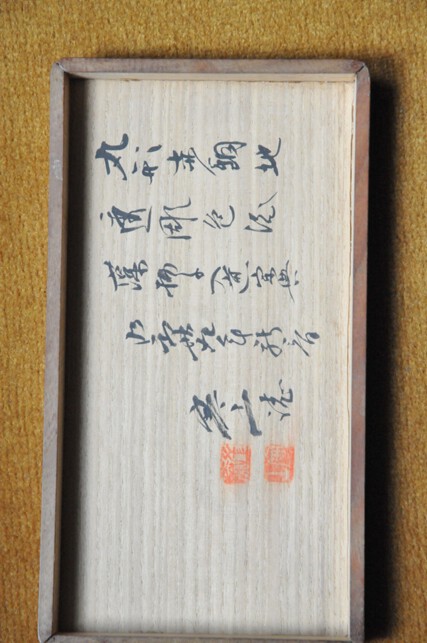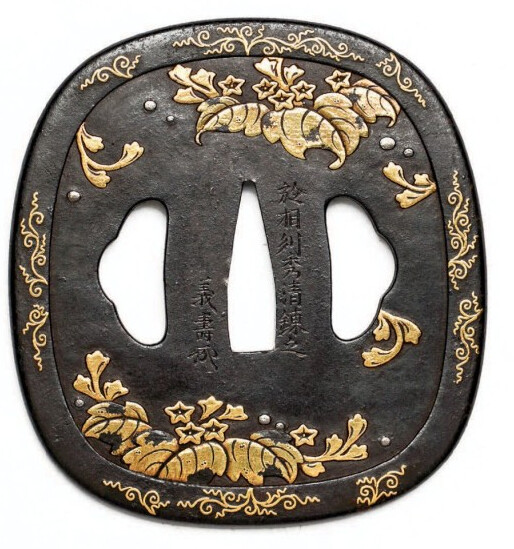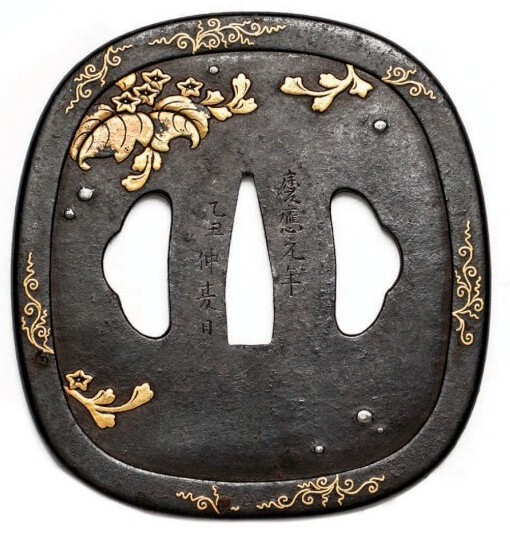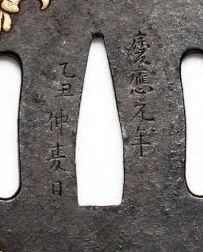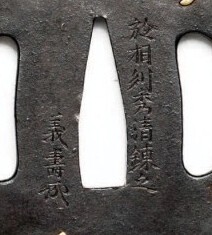-
Posts
161 -
Joined
-
Last visited
Content Type
Profiles
Forums
Events
Store
Downloads
Gallery
Everything posted by Marc BROQUIN
-

Interesting Odd Shape Tsuba for you collectors out there
Marc BROQUIN replied to Infinite_Wisdumb's topic in Tosogu
Hello, May I propose to you to look on the KINKO MEIKAN the TERUTOMO signatures, p379. From various discussions with experienced people, it seems that TERUTOMO was the main preparer of OMORI TERUHIDE in order to face the requests of clients. If so the quality should be above that which is figured on the pics. I own myself a FK from OMORI TERUTOMO which got TOK HOZ, and the work is totally different. The kao, to speak only of that, is different from KINKO MEIKAN ones. IMO it should be a copy. Best Marc -
Hello all, Thanks to Bruno for the research of connected signatures. This Shigeyoshi on KINKO MEIKAN page 158 top left seems effectively corresponding to the one above. When I check on the Haynes book (The index of Japanese Sword Fittings and associated artists),the first comming TACHIBANA SHICHIZAEMON SHIGEYOSHI (H.08573.0) is given around 1625. The next one (H.08576.0) is cited around 1700 As written, this SHIGEYOSHI was said to have taken the UMETADA school from KYOTO to EDO; But : the many various signatures of UMETADA SHIGEYOSHI are not defined or understood fully at this time. In my opinion, this tsuba doesn't seem to correspond to 1625 era but later, obviously after 1750. So the question is still pending ..... Many thanks by advance for the efforts. Best Marc
-
Hello everybody, I just post this later UMETADA TSUBA searching for infos about signature which is not so common : UMETADA HEN TACHIBANA SHIGEYOSHI SAKU An idea about the tanko/kinko tsubako ? Something around 1800/1850 AD ? or older ? All the idea are welcome. Best Marc
-
Hello, My friend got a nice kozuka with a lot of kanji. Delicate (very) to read. Could you try ? Best Marc
-

FUCHI KASHIRA from a certain KATSUYUKI
Marc BROQUIN replied to Marc BROQUIN's topic in Translation Assistance
Hello, If it was BUNSAI ? instead of JOSAI it could match in terms of inscription. -
-

Anyone Care To Give Their Opinion As To Which School?
Marc BROQUIN replied to Nickupero's topic in Tosogu
Hello, My first impression, before looking to the answer of Mantis Dude was SHOAMI (from the north AIZU or AKITA ?). This design is well known but not so much in this quality. Thanks to have shared your treasure. Marc -
Hello dear friends, Many thanks for info and comments Yes RON, precisely I would like to find pics about this JUYO BIJUTSUHIN HISAKUNI, for which Jim Kurrasch wrote an article around 2006, with a pic of tang and extreme part of blade, under the term JUYO BUNKASAI HISAKUNI TACHI Hello Peter, I know those articles from Markus,but this particular blade is not represented in them. Hello John, those tangs do not belong to the JUYO BIJUTSUHIN HISAKUNI. Anyhow, many thanks for attention and efforts. Best regards Marc
-
Hello, I am progressively completing my data and would like to find good pics of this sword (AWATAGUCHI HISAKUNI), which once was the subject of an article by our late friend, Jim Kurrasch. Is anybody able to send me some pics of this blade? Thank you by advance. Best regards Marc
-
Hello, Many thanks Jussi. But which one does seem better ? Should we wait some more answers, in order to settle the best one ? An other track is the writing of wakizashi 脇差 where the second kanji is the same as the second one of Kajihara San version. Should we see there an indication ? Anyway, thanks for your help. Best Marc
-
Hello guys, I have tried by several means to find the exact kanjis for HANZASHI KOZUKA : kozuka of reduced size for aikuchis or tantos. Any suggestion ? Best regards Marc
-
Hello, The only tangible thing is this gold writing. The sword is not attributed for the moment, has no paper and there is no indication in this way with the saya. And of course no signature on the other side. Strange and dubious for me ( as we say in french : too beautiful to be honest). Best Marc
-
Hello Jean, As far as I can read. The first vertical line on right could be : MARU GATA SHAKUDO JI. I let the rest for the moment to the more educated people. Best Marc
-
Hello, A friend of mine asked me some help to translate this gold inscription. Many thanks for your help. Best Marc
-
Hello dear friends, I have begun to translate this hako gaki but I am not sure completely. Many thanks by advance for the help. Best regards Marc
-
Hello Justin, A little precision about Musee Guimet. The best way to visit Paris is to use the subway, le Metro, and the nearest station on line 9 towards Pont de Sevres, is Alma-Marceau. The main exit leads one side of the big square and Musee Guimet is on the opposite side, behind the central statue of the square. Regarding the Japanese art dealers, there are only three Japanese dealers offering tosogu and kodogu inside Paris. In Marchee au Puces you can find one or two others. And I know very well a french polisher having some nice pieces (P. Sabbah). If you want to contact me for my phone number, send me PM at marc.broquin@free.fr. Best regards Marc P.S. : The Louvre dealer is now in Le Village Suisse between the station Dupleix and the station Ecole Militaire. He is open only on Saturday and Sunday.
-
Hello All, I bought some months ago the original issue (1910) of the NAUNTON Collection by JOLY. This catalogue/book has been at that time printed in 300 copies plus the usual copies for expert and owner. In fact mine doesn't bear any number and on the second covering page the signature of NAUNTON appears. Is there someone having a certified signature of GH NAUNTON, in order to compare. Many thanks by advance Best regards Marc
-

Help For This Yoshitoshi Tsuba
Marc BROQUIN replied to Marc BROQUIN's topic in Translation Assistance
Dear Morita San and Moriyama San, I do appreciate your help largely. Thank you very much for that. In return if you find sometning in french you could not understand, it would be a pleasure for me to help you back. Sincerely Marc -
Hello all, I have some difficulty to identify this YOSHITOSHI which could be an Edo Higo tsubamaker and also to read the obverse mention on the right side. Thanks for your help Kind regards Marc
-
Hello all, I tried YOSHIKAZE or ASHIKAZE with the HAYNES without success. But I found an ASHIFU Haynes H.00157.0 (family name : Fuyotei, or Nobuie) with the artisic name TOZAEMON, living in Sunshu (Suruga Province) in the early Meiji's years, around 1875, but unfortunately the kao in the Haynes doesn't fit with this one on the fuchi, so .... Hoping this could help. Best Marc
-
-
Hello David & Curran Yes of course it is not the particular tsuba of TOHACHI by Sasano, which by the way was for sale on the site of Fred WEISBERG some months ago. I own this tsuba, sold by Robert BURAWOY, well known dealer in France, having worked with Robert HAYNES and now retired. Thanks for the info about punching marks. Best regards Marc
-
Hello, What I got from the Net is : "Citrus Tachibana (CITRUS RETICULATA, BLANCO) Romaji Tachibana English Mandarin orange Kanji 橘 Kana たちばな Season Summer Seasonal Exceptions Winter Auspicious Yes Motif Type Fruit Motif Audio Coming Soon Tachibana (English: Mandarin orange, botanical: Citrus tachibana) is an inedible citrus of approximately 6 to 13 ft in height, grows in dense green branches with young thorns. The leaves are 3 to 6 cm in length, oval-shaped, and glossy dark green. The fruit is smooth-skinned, about 3 cm in diameter, but with a high acidity that makes it is unfit to be eaten raw, though marmalade can be made. In Japan, the leaves and fruit is used in floral motifs and adopted as family crests. Seasonal Use, Exceptions & Pairings Thought to be brought from the legendary eternal land, tachibana is emphasized in poetry for its evergreen leaves, fragrant blossoms, and jewel-like fruit lasting into winter. Though its flowers bloom "out of season", the leaves and fruit motif of tachibana is commonly seen on lined garments meant for the auspicious occasions like the New Year or Coming of Age. For a Heian-era perspective, Minamoto Masasuke, an aide to Senior Grand Empress Fujiwara no Tashi (1140–1202), wrote in "Colors for a Court Lady's Dress" that the tachibana kasane - a golden yellow citrus fruit occurring simultaneously with a white flower - is assigned to the summer cultural season. [1] Likewise, Tachibanaduki (橘月/たちばなづき) is an antique name for the fifth lunar month, or June in the modern calendar. In order to determine the correct season, type of weight and weave of fabric must be considered along with whether it is lined and any additional motifs." Best Marc
-
Hello guys, :D This is the picture of this HIGO tsuba, said by SASANO SAN to be from HAYASHI TOHACHI. What is strange is that Mr ITO'book doesn't refer to this tsuba for HAYASHI TOHACHI. To be or not to be .... Anyhow the picture is good enough to enjoy. :D Best to all. :D Marc




.jpg.a08095f8666c5298167dbe6aa30f1cc9.jpg)
.jpg.e95ae7c4062fffe128e0b257c7557482.jpg)





